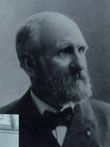Today in Syracuse, New York, Winfield Scott, freshly graduated from Baptists’ Rochester Theological Seminary, is ordained by the Seneca Baptist Association.
Born on February 26, 1837, in West Novi, Oakland County, Michigan, Winfield is the first son and fourth child in a large family of three brothers and four sisters. At the time of his ordination, he has been a Baptist for eight years. On his graduation day from Rochester Seminary, he married Helen Louise Brown, a native of New York.
As do many Baptist pastors in the North during the war years, Scott soon expresses his patriotism by joining the Union Army. In July 1862, Scott and 98 men he recruited from his town of Farmer Village and the surrounding area form New York’s Company C, 126th Regiment. Scott is appointed Captain and serves as the company’s chaplain. The company fights many battles during the war years and Scott is wounded several times, a wound in 1864 finally causing him to leave the army.
His military service over, in the years following Winfield Scott and his family move west, where he pastors Baptist churches in Leavenworth, Kansas and Denver, Colorado.
Yet it is Scott’s activities after all of this that leave a unique and lasting legacy in American history, for Winfield Scott’s life journey eventually leads him to become the founder of Scottsdale, Arizona.
As related by the Scottsdale Historical Museum:
In 1881, Scott applied to the Secretary of the Army to become an Army Chaplain and was confirmed on July 27, 1882. Chaplain Scott¹s first post was in Fort Canby, Washington Territory. He then went to Ft. Stevens, Oregon and then to Angel Island in San Francisco.
In mid February of 1888, Winfield Scott was invited to the Salt River Valley in Arizona. Some residents of Phoenix had heard of Scott¹s reputation as a promoter and wanted him to help promote Phoenix and the surrounding area. Scott was impressed with the valley and on July 2, 1888 made a down payment of 50 cents an acre for a section of land in what is now Scottsdale. His brother, George Washington Scott, came at Winfield Scott¹s request to clear the land. He planted 80 acres of barley, 20 acres of vineyards and a 7-acre orchard.
Scott was then transferred to Ft. Huachucha, Arizona Territory in February of 1889. In 1892 after 10 years as an Army Chaplain, Winfield Scott took a leave of absence from the military and went to his farm in Scottsdale. His Civil War wounds bothered him greatly and in 1893 he finally retired.
The Scotts welcomed many people to live on their property whether they were ill, down on their luck or just looking for a fresh start. Many lived in tents in the orchard. During this time Scott became active in Arizona politics while promoting farming in the community.
Application was made to form a school district on July 13, 1896. The first one room school was built soon after. In September 1909, a new brick school building opened. It was dedicated on February 26, 1910. This building now houses the Scottsdale Historical Museum.
In early October 1910, Scott became ill. He died in Phoenix, Arizona on October 19.
Chaplain Winfield Scott spent half a century in service to his God, his country and his fellowman. He built churches, organized congregations, served as a soldier, was confirmed as an Army Chaplain and became an educator and active politician. But most of all we will remember him as the founding father of Scottsdale, Arizona.
Note: Chaplain Winfield Scott is not to be confused with the Union General of the same name.
Sources: “Winfield Scott Exhibit,” Scottsdale Historical Museum (link); “Winfield Scott and Scottsdale, 1888 to 1896,” First Baptist Church of Scottsdale, including photo (link); see also Richard E. Lynch, Winfield Scott, A Biography of Scottdale’s Founder, published by the City of Scottsdale, 1978 (link)



